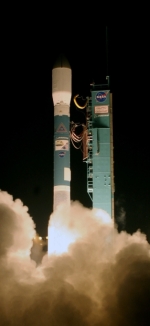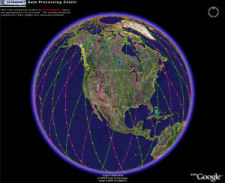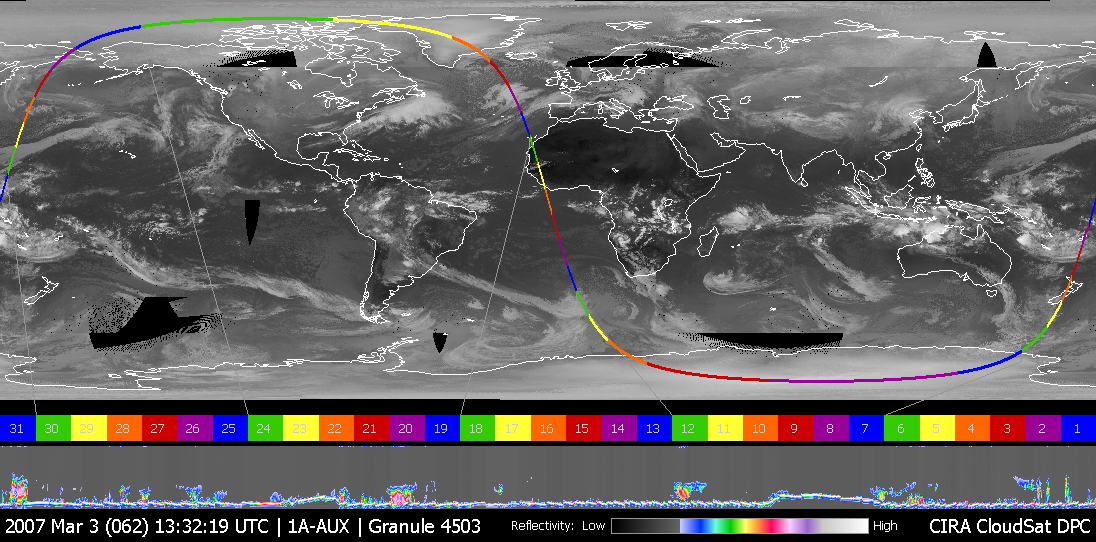|
|
 |
| News: Home |
 |
 |
18 January 2008
-
On 18 January, the CPR (Cloud Profiling
Radar) was transitioned from Operate Mode to
Intialize Mode by autonomous fault protection.
Initial analysis showed that two body current
trips occurred in the High Power Amplifier -2
(HPA2). The spacecraft was in Sun, power was
nominal and ADCS was nominal. This incident is
similar to another that occurred in April 07.
HPA body current trip events are known and
expected, but the cause of the termination of
the restart sequence after two (as in April 07),
rather than three, sequential trip events, is
under investigation.
The CPR was ground-commanded to Transmit Mode
on Tuesday, 21 January, and is collecting data.
Both the CPR and spacecraft are healthy and
functioning nominally.
12 December 2007
-
CloudSat Principal investigator Graeme
Stephens and scientists Jen Kay and John Haynes
presented a press conference at the 2007 annual
AGU conference. At the press conference, new
discoveries regarding sea-ice extent
sensitivity, global rainfall patterns, and
aerosol effects, all using CloudSat
observations, were unveiled. Download the press
conference presentation here
(MS PowerPoint file, 7.8 MB)
4 July 2007
-
On July 4 CloudSat executed a maneuver
designed to avoid a close approach with an
Iranian satellite, SINAH 1. The close approach
was predicted to occur on 6 July. CloudSat is a
NASA satellite managed by the Jet Propulsion
Laboratory (JPL) in Pasadena, CA and is operated
by the U.S. Air Force Space Development and Test
Wing (SDTW) at Kirtland Air Force Base, New
Mexico. This was the first such "collision
avoidance" maneuver by CloudSat in over a year
of operation.
The close approach was first identified on
July 1 during daily screening for any space
objects predicted to come within one kilometer
of CloudSat over the following five days. The
predicted miss distance was about 100 meters.
Based on uncertainties in the orbit predictions
the probability of collision was estimated to be
greater than 1 in 10000. CloudSat managers at
JPL considered this sufficient risk to plan a
maneuver while continuing to monitor the daily
reports.
Orbit planners at SDTW advised JPL that
CloudSat could be moved forward in its orbit
about five kilometers over two days by firing
thrusters to reduce CloudSat's speed by 1
centimeter per second. This would make the
predicted closest approach with SINAH 1 over
four kilometers, and eliminate the possibility
of a collision. Doing the maneuver two days
prior to the conjunction made it possible to
generate the desired separation with a smaller
maneuver and also allowed time to execute a
back-up maneuver in case the planned one failed.
When the reports on July 2 and 3 also predicted
miss distances around 100 meters, JPL gave the
go ahead to execute the maneuver. The maneuver
was executed early on July 4 and subsequent
screening based on CloudSat's new orbit,
determined from its on-board GPS, confirmed that
the miss distance was over four kilometers.
CloudSat is part of a group of NASA
satellites known as the Afternoon Constellation
and maintains a separation of 75 to 112
kilometers with CALIPSO, its nearest neighbor in
the constellation. The maneuver on July 4 was
similar to the maneuvers CloudSat has conducted
every few weeks in order to maintain this
formation with CALIPSO. CloudSat conducted
another maneuver on July 7, after the
conjunction, to reverse the drift caused by the
maneuver on July 4 and maintain the formation
with CALIPSO.
28 April 2007
-
CloudSat Celebrates One Year in
Orbit

CloudSat, a satellite mission conceived by
Colorado State University scientist Graeme
Stephens, celebrated its first anniversary on
Saturday, 28 April, as the world's most
sensitive cloud-profiling radar in orbit.
Since launching into an orbit 705 km (438
miles) above Earth on 28 April 2006, CloudSat
has made 5,307 orbits around the Earth, snapped
162 million vertical profiles of clouds and
distributed more than 6 terabytes of data to the
international science community, according to
the Cooperative Institute for Research in the
Atmosphere, or CIRA, which is based at Colorado
State and is responsible for the satellite's
data collection.
In this mission, Stephens, a University
Distinguished Professor in atmospheric science,
provides the scientific guidance and is
responsible for the mission's success while
NASA's Jet Propulsion Laboratory manages and
implements the mission. CloudSat is one of only
three principal investigator-led Earth science
missions launched or about to be launched by
NASA and is one of the very few Earth missions
that has had such university leadership.
Other partners include Ball Aerospace and
Technologies Corp., which built the spacecraft
for the CloudSat mission, the U.S. Department of
Energy, the U.S. Air Force, and the Canadian
Space Agency.
CloudSat is the first radar to look
vertically at the characteristics of clouds,
particularly water and ice content that could
someday help scientists better predict weather
patterns and climate changes. Researchers around
the world will benefit from the radar's data
about cloud processes. In addition to improving
weather forecasting, the data will help
scientists understand how clouds determine
Earth's energy balance, thus increasing the
accuracy of severe storm warnings, improving
water resource management, and developing more
advanced radar technology.
During the expected 22-month duration of the
mission, CIRA will process and store about 12
terabytes of data. A terabyte is one million
megabytes - a megabyte has enough disk storage
to hold about 20,000 average-sized e-mail
messages.
The CloudSat spacecraft is flying in orbital
formation as part of a constellation of
satellites, including NASA's Aqua and Aura
satellites, the French Space Agency (CNES)
PARASOL satellite and the NASA-CNES CALIPSO
satellite. This is the first time that five
research satellites are flying together in
formation.
Recent CloudSat news items:
16 April 2007
- The CPR switched to Initialize Mode at 1016
UTC on 12 April 2007. Science data was not
collected from this time until re-activation at
1529 UTC on 16 April 2007. This anomaly is of
the same kind as the anomalies of 16 June and 17
July 2006.
21 March 2007
- A commanding error at 2214 UTC on Saturday,
17 March 2007, caused the radar to be taken
offline and the spacecraft to be transitioned to
standby. Data collection resumed at 1429 UTC on
Wednesday, 21 March.
5 March 2007
-
New and Improved CloudSat Tools
Online
Several online tools for visualizing CloudSat
data and ground tracks have been developed or
improved in recent months.

Chris Galli and Jay Mace of the University of
Utah have developed the CloudSat/MODIS
Joint Atmosphere Map Browser (listed in the
Quick Links as "Google Maps CloudSat Browser"),
which overlays CloudSat ground tracks over
various MODIS cloud fields on a Google Maps map.
Pop-up plots showing CloudSat profiles along the
ground-track are obtained by moving the cursor
along the plotted ground track. An earlier
version of the tool, the CloudSat
Beta Profile Browser (also in the Quick
Links), shows similar combinations of CloudSat
and MODIS data, but at a different scale with
better coverage of high latitudes.

Phil Partain of the CloudSat DPC has
developed experimental orbit track files
designed for use with Google Earth; these are
available at the DPC Google
Earth Resources page, which is included in
the Quick Links. Tracks files are available at
both 2-minute and 5-second resolutions, together
with other files showing the CloudSat
calibration region boxes and the tracking
stations that downlink CloudSat data.

The QuickLook
page at the DPC (in the Quick Links) has
received a number of updates to make it more
informative and easier to use. Information has
been added to each granule listing that
indicates if there are missing profiles, if the
transmitter was not operating, or if a
calibration maneuver was performed. These
conditions are flagged with a colored box.
Clicking on the box will pop-up a window with
more details. The page navigation pull-down menu
now includes the granule number and date/time
for the first granule on each page, making it
much easier to jump directly to a page
containing a granule you might be interested in.
Finally, the quicklook page has been optimized
so it should load much faster than it did in the
past.
26 January 2007
-
CloudSat Standard Data Products Released to
Science Community

The CloudSat Data Processing Center (DPC) has
released a Beta version of the final 3 Standard
Data Products (2B-CWC-RO, 2B-TAU, 2B-FLXHR).
These data are now available to the general
science community. (The above image is ice water
content from 2B-CWC-RO on 15 Oct 2006.)
It is important for all users to note that
these three products, as well as all of the
CloudSat Standard Products in release 03
(identified in the filename as "_R03_" ) are
provisional products that are still undergoing
validation by the CloudSat Science Team. These
products will be superseded by Release 04
on/about July 2007 and will, at that time,
address known issues and other findings from the
results of ongoing validation efforts during the
remainder of our first year of data collection.
In particular, the CWC, TAU, and FLXHR products
are only released at this time for the period of
15 Oct-15 Nov 2006 to allow the science
community to become familiar with them and to do
their own quantitative assessment of these
initial CloudSat products.
All data users are asked to review the known
issues page of the Data Processing Center
website and become familiar with these issues
before using the results in publications or
presentations. In addition, please report any
additional anomalies or questions to the DPC via
email or the contact
page.
Other resources:
| |